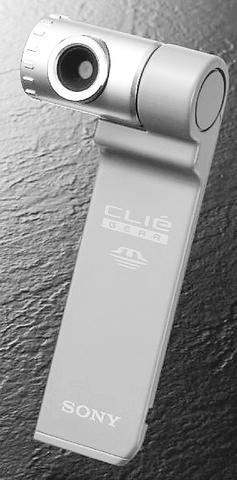There's an old saying in the high-tech industry: Give a man a fish and you feed him for a day. But let him license your operating system and he has the foundation for a thriving enterprise that, through selective innovation and cooperative cross-promotion, expands market share for both licensee and licenser.
That, at least, is the thinking at Palm Inc, the company that invented the PalmPilot organizer and its successors. Hoping to emulate the model of Microsoft, which collects billions of dollars from computer companies such as Dell and Hewlett-Packard that design PCs around Windows, Palm signed licensing agreements with Handspring, IBM, Sony and many others, permitting them to make what amount to Palm clones.
Some of the resulting palmtops add delicious features to the basic Palm programs -- date book, address book, to-do list and memo pad. Sony's new Clie PEG-T415, which arrives in stores this week, is a shining, and shiny, case in point. At less than four-tenths of an inch thick and clad in a black or silver case of sculptured aluminum, it's not only the slimmest palmtop in the world, but also one of the most beautiful.

PHOTO: NY TIMES
The T415's thinness isn't designed purely for wow factor, either. It makes keeping the device with you at all times effortless. After all, what's the point of a machine that you start leaving in the drawer just to avoid the lumpy feeling of a sub sandwich in your pocket?
Sony, moreover, is one of the few palmtop companies that puts almost as much thought into the screen cover as into the device itself. On the T415, you can flip open the jet-black cover with a wrist snap, making the whole affair look like the descendant of the Star Trek tricorder (or its ancestor, depending on how seriously you take Star Trek).
Like all of the Sony Clie models, the T415 comes with a handy thumbwheel at its upper left edge. You turn it to highlight items on the screen, and push it in to open them. In conjunction with the Back push button just below it, this wheel lets you operate all of the included programs with one hand, a feature you really appreciate when you're holding a cell phone, umbrella or ice cream cone in the other hand.
Also, like earlier Clie models, the T415 has a Memory Stick slot that can accommodate memory cards (64 megabytes for US$60), a new Sony digital camera that takes 320-by-240-pixel color photos (US$150) or a new audio adapter that plays MP3 music files you've stored on the Memory Stick (US$130). That's all fine, but it's even more amazing that Memory Sticks fit into this thing at all. It must have been quite an engineering coup to squeeze a card slot into a machine that's about as thick as a slice of ham.
A gorgeous, ultrathin palmtop that comes with eight megabytes of memory, a vibration-only alarm mode and version 4.1 of the Palm operating system would have sold just fine. But Sony took the opportunity to introduce two solid new features to its product line.
First, Sony has done something ingenious with the T415's infrared transmitter. Yes, you can use it to beam information, electronic business cards and programs to other organizers, just as you can on any Palm. But when you run Sony's Remote Commander program, which fills the screen with touch buttons, you turn this palmtop into a remote control that can operate about 20 brands of current home-entertainment gear. In tests at an electronics store, my Clie controlled the basic functions of dozens of different televisions, VCRs, amplifiers and DVD players without any trouble (except from the salesclerks).
Of course, advanced Palm fans have used their palmtops as television remotes for years, using shareware programs such as OmniRemote. The trouble is that the range of the standard Palm's infrared transmitter is only about three feet, requiring a dash into the television's personal space every time you want to change channels. But Sony's bionic infrared signal reaches gear up to 15 feet away, forever eliminating those athletic interruptions to your channel surfing.
The second standout T415 feature is its superior speaker circuitry, which can play back MIDI music files and standard digitized (WAV) sound files from the Internet. When you have to press your palmtop into service as an alarm clock in some chintzy motel, no longer must you awake to faint electronic chirps. Now your day can begin with the strains of Bach, beach sounds or Bart Simpson.
The T415's best spec, however, is its price: US$300, the same as Handspring's Visor Edge and US$30 less than Palm's m500. Those larger machines are the Clie's obvious rivals -- they, too, are clearly aimed at the kind of people who pay extra for brushed metal -- but lack the Sony's sound playback and remote-control features. (The Visor also lacks Documents to Go, a program that lets you edit Word and Excel documents on the palmtop.) On paper, in other words, the new Clie's value blows its rivals out of the water.
But the T415 has a few shortcomings. For example, Sony continues to shut out Mac fans. At www.markspace.com, you can download a US$30 program called The Missing Sync that lets a Clie synchronize the basic data (appointments, addresses and so on) with a Macintosh. But even then, Mac fans can't use some of Sony's utility software, Windows-only programs that let you transfer photos and short movie clips to your Clie.
The T415's real Achilles' heel, however, is its screen. Ordinarily, grayscale screens like this one offer striking advantages over color models: savings of US$100 or more, thinner electronics, better contrast in a wide variety of lighting conditions and much better battery life (the T415's built-in batteries run two weeks on a charge). Better yet, Sony has quadrupled the T415's screen dimensions (320 by 320 pixels instead of the usual Palm standard, 160 by 160), resulting in especially crisp, fine text and graphics in all of the included programs.
But on the T415, many of these advantages are lost because the screen is so dim. Blacks are still black, but the greenish background is so dark that the contrast suffers -- and at lower type sizes, the high-resolution, ultrafine text all but disappears against it. The telltale sign that Sony has been fooling around with screen technologies is the fact that the screen is jet black when turned off, rather than light gray as on other Palms. (It makes a fine mirror, though.)
Workarounds are available. Enlarging the type makes a difference, and so does turning on the backlight. It also helps that on this model, the backlight simply illuminates the background, as it should; a welcome change from the annoying white-on-black negative image you get from the backlight of standard Palms.
It's a little odd, and a little sad, that the people who are most significantly advancing the technology of Palm organizers these days aren't at Palm. Instead, the most exciting developments are taking place in the labs of its licensees. Conversely, it's a joy to see a gargantuan corporation like Sony, for example, dreaming up innovative features (like the sound playback and remote-control functions) as though it were a feisty little startup with something to prove.
Best of all, the Clie T415 demonstrates that it's still possible to add powerful, useful functions to this humble slab of circuitry without adding bulk or complexity to the original Palm software design. If it weren't for its dim screen, this svelte, thoughtfully designed, Clie would come tantalizingly close to achieving palmtop perfection.

DEFENSE: The first set of three NASAMS that were previously purchased is expected to be delivered by the end of this year and deployed near the capital, sources said Taiwan plans to procure 28 more sets of M-142 High Mobility Artillery Rocket Systems (HIMARS), as well as nine additional sets of National Advanced Surface-to-Air Missile Systems (NASAMS), military sources said yesterday. Taiwan had previously purchased 29 HIMARS launchers from the US and received the first 11 last year. Once the planned purchases are completed and delivered, Taiwan would have 57 sets of HIMARS. The army has also increased the number of MGM-140 Army Tactical Missile Systems (ATACMS) purchased from 64 to 84, the sources added. Each HIMARS launch pod can carry six Guided Multiple Launch Rocket Systems, capable of

TRAJECTORY: The severe tropical storm is predicted to be closest to Taiwan on Wednesday and Thursday, and would influence the nation to varying degrees, a forecaster said The Central Weather Administration (CWA) yesterday said it would likely issue a sea warning for Tropical Storm Podul tomorrow morning and a land warning that evening at the earliest. CWA forecaster Lin Ting-yi (林定宜) said the severe tropical storm is predicted to be closest to Taiwan on Wednesday and Thursday. As of 2pm yesterday, the storm was moving west at 21kph and packing sustained winds of 108kph and gusts of up to 136.8kph, the CWA said. Lin said that the tropical storm was about 1,710km east of Oluanpi (鵝鑾鼻), Taiwan’s southernmost tip, with two possible trajectories over the next one

Tropical Storm Podul strengthened into a typhoon at 8pm yesterday, the Central Weather Administration (CWA) said, with a sea warning to be issued late last night or early this morning. As of 8pm, the typhoon was 1,020km east of Oluanpi (鵝鑾鼻), Taiwan’s southernmost tip, moving west at 23kph. The storm carried maximum sustained winds of 119kph and gusts reaching 155kph, the CWA said. Based on the tropical storm’s trajectory, a land warning could be issued any time from midday today, it added. CWA forecaster Chang Chun-yao (張竣堯) said Podul is a fast-moving storm that is forecast to bring its heaviest rainfall and strongest

CRITICISM: It is deeply regrettable that China, which is pursuing nuclear weapons, has suppressed Taiwan, which is pursuing peace, a government official said Representative to Japan Lee Yi-yang (李逸洋) yesterday accused Beijing of interference after Taiwan’s official delegation to the Nagasaki Peace Memorial Ceremony in Japan was assigned seating in the “international non-governmental organizations [NGO]” area. “Taiwan is by no means an international NGO, but a sovereign nation that is active on the international stage,” Lee said. Lee and Chen Ming-chun (陳銘俊), head of the Taipei Economic and Cultural Office (TECO) in Fukuoka, attended the ceremony in Nagasaki yesterday, which marked the 80th anniversary of the atomic bombing of the city. That followed Lee’s attendance at the Hiroshima Peace Memorial Ceremony on Wednesday